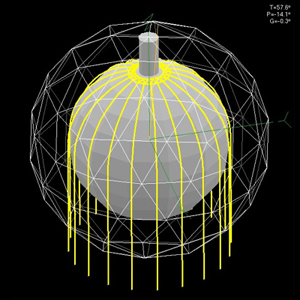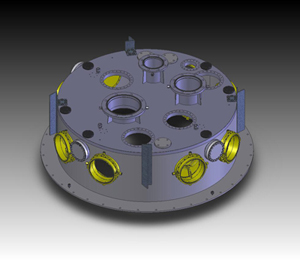As one of the founding members of TRIUMF, the University of Alberta is a Canadian leader in particle physics. And just like for TRIUMF, not all of the science experiments are conducted on campus in Edmonton. Rather, the students and faculty at Alberta find the best science projects elsewhere in Canada or abroad and partner up to contribute, participate, and reap the rewards. One such example is the SNO+ project under development in northern Ontario. With technical and engineering support from TRIUMF, the University of Alberta team is a key contributor.
Plans for upgrading the SNO detector are currently underway at SNOLab in Sudbury, Ontario. SNO used heavy water (contains more of the hydrogen isotope deuterium compared to regular water) to detect neutrinos from the sun and study their properties. SNO+ is a follow-up experiment in which the heavy water will be replaced with liquid scintillator (an organic liquid similar to mineral oil that gives off light when charged particles pass through it), allowing further study of these mysterious particles. Neutrinos are similar to electrons but they have no electric charge, therefore they only interact via the so-called “weak” force. Thus, they are capable of travelling through the Earth and sun with little to no effect. Much remains unknown about neutrinos, but the University of Alberta and TRIUMF, along with 16 other universities and labs from Canada, the United States, Germany, the United Kingdom and Portugal, are hoping to learn more about these particles with the SNO+ experiment.
Before any experiments can take place, many upgrades are needed to get the SNO detector ready for the SNO+ experiment. Recently, the 1,000 tonnes of heavy water used in the SNO experiment have been removed to allow 800 tonnes of liquid scintillator to replace it. Since the liquid scintillator is much lighter than the heavy water, an apparatus must be designed to hold down the acrylic vessel. The University of Alberta designed a series of ropes that loop around the neck of the vessel and connect to the floor in order to keep the vessel from floating upward.
Another challenge of the SNO+ experiment is dealing with the radon gases emitted naturally by the rock below the surface of the Earth. Therefore, a universal interface must be made to seal the top of the vessel in order to prevent these gases from contaminating the detector. TRIUMF is currently designing and manufacturing this, along with the calibration equipment such as the source manipulator systems. These systems are mounted on top of the universal interface, and need to be able to tolerate the liquid scintillator as well as prevent any radon gas from entering.
Leading the progress at TRIUMF is Richard Helmer, who is currently working on building the universal interface. TRIUMF is also working on experiment simulations using “Monte Carlo” methods (computational algorithms which rely on repeated random sampling to produce their results) in conjunction with the University of Alberta. Two undergraduate students from the University of British Columbia are currently working on this as well.
One of the leaders of the University of Alberta effort is Professor Aksel Hallin, a Canada Research Chair in Astroparticle Physics. He earned his Ph.D. from Princeton University and has been interested in the mysterious, shadowy world of neutrinos and dark matter ever since. He noted that current models show neutrinos actually take up more mass in the universe than the rest of everyday matter. His interest is fueled by how little we know about this “commonplace” particle that could play a dramatic role in the evolution of the universe. Professor Hallin commented that the partnership with TRIUMF to design, engineer, and fabricate some of the SNO+ components has been crucial — the laboratory has unique skills and equipment that are only possible because so many universities have come together to pool their resources and talents. Working with him is Carsten Krauss, an assistant professor at the University of Alberta. Carsten has been central to much of the design, installation and modification of the cavity infrastructure.
The University of Alberta also has several students involved with this project. Logan Sibley, a PhD student, is currently working on radioactive sources to be deployed inside the detector. The main challenge is that these sources need to be completely sealed so they don’t contaminate the detector. Another student Zack Petriw, studying for his Masters degree, is currently developing the hardware and software for a set of cameras to be mounted inside the detector, allowing scientists to precisely measure the position of objects within it.
The SNO+ experiment will run for approximately 10 years, starting later in 2012. Within these 10 years, there will be different experiment phases focusing on different elements of study regarding neutrinos. For example, there will be a double beta decay phase in which scientists will hope to determine whether or not neutrinos are Majorana or Dirac particles. Majorana particles are their own anti-particles (unlike Dirac particles); therefore if this is true of neutrinos, neutrinoless double beta decay may be observed. This experiment will provide scientists with a measurement of the neutrino mass since the rate of neutrinoless double beta decays is related to the square of the neutrino’s mass.
Overall, SNO+ will give great insight to the mysterious neutrino particles, and will answer some of the most important questions in neutrino physics. Thank you, UofA for helping to lead the way! -- Lindsay Davies, Communications Assistant | 
An example of what the rope contraption may look like
(taken from SNO+ website) 
Design for the top of the Universal Interface
|


